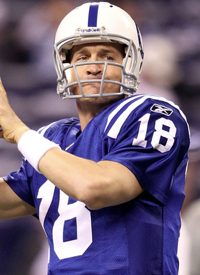
Looking at a season on the sidelines, or possibly the end of his Hall of Fame career, NFL quarterback Peyton Manning (#18, left) apparently traveled recently to Europe for a medical procedure that has not been approved in the United States: adult stem cell therapy.
Manning, who led the Indianapolis Colts to a Super Bowl victory in 2007, “has had three surgeries in 19 months on his bothersome neck, the latest of which caused the four-time NFL MVP to miss his first game in 14 seasons…,” reported Fox News. While few details were immediately available about the procedure, other than those supplied by Fox Sports commentator Jay Glazer, the therapy most likely did not involve embryonic stem cells — a medical procedure condemned by religious and pro-life leaders as destructive of human life.
Rather, reported bioethics expert Dr. David Prentice on LifeNews.com, the therapy most likely used “adipose (fat) derived adult stem cells from Manning’s own body,” a procedure that “bypasses any problems of transplant rejection and is relatively safe.”
Prentice, who serves as a Senior Fellow at the Family Research Council’s Center for Human Life and Bioethics, wrote that “Manning’s adult stem cells may have then been injected around the site of his problem vertebra in the neck, to assist healing and help with spinal disc fusion. In that respect, it sounds similar to the procedure that Texas Gov. Rick Perry received in Houston, Texas, for his back problem.”
Rebecca Boyle of the technology website PopSci.com added her own explanation of Manning’s reported treatment, writing that the Colt’s franchise player likely underwent “a procedure involving induced pluripotent stem cells, or iPS cells, which can be reprogrammed to become any type of cell. Glazer said he was informed that doctors cultured some of Manning’s own fat cells and injected them into his neck, where they would ideally help regenerate damaged tissue. Researchers showed back in 2009 that fat cells could easily be turned into iPS cells, and do so much more quickly than the other common iPS cell progenitor, skin cells.”
Glazer apparently suggested that while adult stem cell therapy is not practiced in the United States, embryonic stem cell therapy is, a misconception Prentice corrected. “It’s true that the only three approved clinical trials experimenting with embryonic stem cells are in the U.S.,” Prentice noted, “with a total of four patients known to have been injected with the dangerous embryonic stem cells, and no results as yet.”
However, Prentice continued, “there are actually over 2,200 FDA-approved adult stem cell clinical trials ongoing or completed, most of which … are in the U.S. That includes several adult stem cell trials using adult stem cells for spinal fusion, and even a couple of adipose-derived adult stem cell trials in Indianapolis.”
Prentice editorialized that perhaps Manning “realized that only adult stem cells had real potential for safe and ethical treatment of patients. Hopefully, he will talk about his experience so more people understand the difference between embryonic and adult stem cells.”
Ultimately, noted PopSci.com’s Boyle, “the fat-stem-cell procedure was insufficient, leading to Manning’s third neck surgery Sept. 8. The anterior fusion of two neck vertebrae was a success, but the future Hall-of-Famer will be sidelined for two to three months, likely missing the entire regular season.”
Apparently, Manning isn’t the only NFL star attempting to save his playing career with stem-cell therapy. According to the Korea Times, free agent wide receiver Terrell Owens traveled recently to South Korea for adult stem-cell therapy to help repair a knee injury that prevented him from playing in 2011. In addition to conventional treatment, reported the paper, Owens was to have “stem cells collected as part of the treatment, Lee Jung-no, doctor and president of the Chaum Anti-Aging center, said in a phone interview…. ‘Mr. Owens starts with therapy Monday followed by the collecting and storing of his stem cells the next day,’ Lee said.”
The paper explained that Owens’ visit to the facility came “after a recommendation by Dr. James Andrews, a specialist in sports medicine working at Andrews Sports Medicine and Orthopaedic Center in Birmingham, Ala.”



